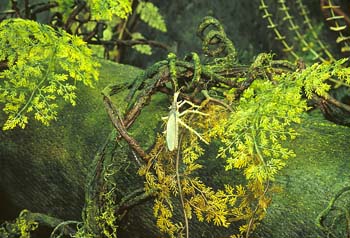Tropical Forest: Plants of the Uplands

Illinois State Museum Exhibit
Megalopteris and Lesleya were found in the uplands. These tall trees dominated the upland forest canopy and shed their leaves seasonally. Another common upland tree, Palaeopteridium, had fern-like foliage and was closely related to the Archaeopteris trees that had dominated Upper Devonian forests over 40 million years earlier.
The seed fern Medullosa, with its large fronds, and the sprawling Cordaites, with long strap-like leaves, were understory trees. Both also occurred in swamps, but in different forms that allowed them to live in wet soil. Medullosa became extinct at the beginning of the Permian Period, 70 million years later. Cordaites is the ancestor of modern conifers, such as pine and spruce.
Lepidodendron and Mesocalamites were common in lowlands but also grew along upland rivers and streams. In moist areas, ferns, such as Alloiopteris joined them.
Sphenopteris and Rhodeopteridium were
vines that clung to tree trunks. Their lacy leaves gave the uplands a jungle-like
appearance. Vine-like plants also covered the ground. The delicate and rare
Gulpenia was
unique to the uplands. Sphenophyllum was the most common
vine-like plant in this environment.